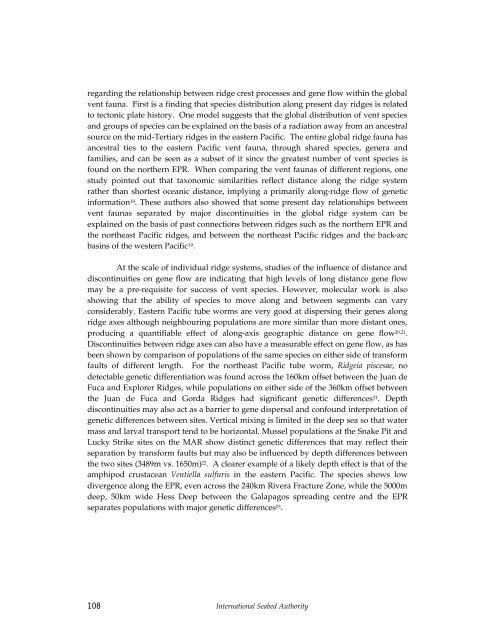Full page fax print - International Seabed Authority
Full page fax print - International Seabed Authority
Full page fax print - International Seabed Authority
You also want an ePaper? Increase the reach of your titles
YUMPU automatically turns print PDFs into web optimized ePapers that Google loves.
egarding the relationship between ridge crest processes and gene flow within the global<br />
vent fauna. First is a finding that species distribution along present day ridges is related<br />
to tectonic plate history. One model suggests that the global distribution of vent species<br />
and groups of species can be explained on the basis of a radiation away from an ancestral<br />
source on the mid-Tertiary ridges in the eastern Pacific. The entire global ridge fauna has<br />
ancestral ties to the eastern Pacific vent fauna, through shared species, genera and<br />
families, and can be seen as a subset of it since the greatest number of vent species is<br />
found on the northern EPR. When comparing the vent faunas of different regions, one<br />
study pointed out that taxonomic similarities reflect distance along the ridge system<br />
rather than shortest oceanic distance, implying a primarily along-ridge flow of genetic<br />
information 10. These authors also showed that some present day relationships between<br />
vent faunas separated by major discontinuities in the global ridge system can be<br />
explained on the basis of past connections between ridges such as the northern EPR and<br />
the northeast Pacific ridges, and between the northeast Pacific ridges and the back-arc<br />
basins of the western Pacific 10.<br />
At the scale of individual ridge systems, studies of the influence of distance and<br />
discontinuities on gene flow are indicating that high levels of long distance gene flow<br />
may be a pre-requisite for success of vent species. However, molecular work is also<br />
showing that the ability of species to move along and between segments can vary<br />
considerably. Eastern Pacific tube worms are very good at dispersing their genes along<br />
ridge axes although neighbouring populations are more similar than more distant ones,<br />
producing a quantifiable effect of along-axis geographic distance on gene flow 20,21.<br />
Discontinuities between ridge axes can also have a measurable effect on gene flow, as has<br />
been shown by comparison of populations of the same species on either side of transform<br />
faults of different length. For the northeast Pacific tube worm, Ridgeia piscesae, no<br />
detectable genetic differentiation was found across the 160km offset between the Juan de<br />
Fuca and Explorer Ridges, while populations on either side of the 360km offset between<br />
the Juan de Fuca and Gorda Ridges had significant genetic differences 21. Depth<br />
discontinuities may also act as a barrier to gene dispersal and confound interpretation of<br />
genetic differences between sites. Vertical mixing is limited in the deep sea so that water<br />
mass and larval transport tend to be horizontal. Mussel populations at the Snake Pit and<br />
Lucky Strike sites on the MAR show distinct genetic differences that may reflect their<br />
separation by transform faults but may also be influenced by depth differences between<br />
the two sites (3489m vs. 1650m) 22. A clearer example of a likely depth effect is that of the<br />
amphipod crustacean Ventiella sulfuris in the eastern Pacific. The species shows low<br />
divergence along the EPR, even across the 240km Rivera Fracture Zone, while the 5000m<br />
deep, 50km wide Hess Deep between the Galapagos spreading centre and the EPR<br />
separates populations with major genetic differences 23.<br />
108 <strong>International</strong> <strong>Seabed</strong> <strong>Authority</strong>

















